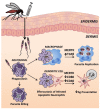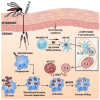Cutaneous Manifestations of Human and Murine Leishmaniasis
- PMID: 28629171
- PMCID: PMC5486117
- DOI: 10.3390/ijms18061296
Cutaneous Manifestations of Human and Murine Leishmaniasis
Abstract
The leishmaniases are diseases caused by pathogenic protozoan parasites of the genus Leishmania. Infections are initiated when a sand fly vector inoculates Leishmania parasites into the skin of a mammalian host. Leishmania causes a spectrum of inflammatory cutaneous disease manifestations. The type of cutaneous pathology is determined in part by the infecting Leishmania species, but also by a combination of inflammatory and anti-inflammatory host immune response factors resulting in different clinical outcomes. This review discusses the distinct cutaneous syndromes described in humans, and current knowledge of the inflammatory responses associated with divergent cutaneous pathologic responses to different Leishmania species. The contribution of key hematopoietic cells in experimental cutaneous leishmaniasis in mouse models are also reviewed and compared with those observed during human infection. We hypothesize that local skin events influence the ensuing adaptive immune response to Leishmania spp. infections, and that the balance between inflammatory and regulatory factors induced by infection are critical for determining cutaneous pathology and outcome of infection.
Keywords: DTH-delayed type hypersensitivity skin test; LST-Leishmania skin test; Leishmania; cutaneous leishmaniasis; diffuse leishmaniasis; disseminated leishmaniasis; kala-azar; mucosal leishmaniasis; post-kala-azar dermal leishmaniasis; skin immunology.
Conflict of interest statement
The authors declare no conflict of interest.
Figures




References
-
- WHO Weekly Epidemiological Record. [(accessed on 31 August 2016)]; Available online: http://www.who.int/wer/2016/wer9122.pdf?ua=1.
Publication types
MeSH terms
Grants and funding
LinkOut - more resources
Full Text Sources
Other Literature Sources
Miscellaneous

